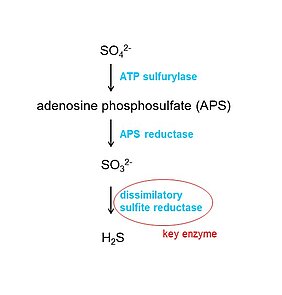The remediation of BTEX-contaminated groundwater, for example via pump & treat, has often proved to be insufficient and economically unacceptable. The aim of the project was to develop an in-situ remediation process under sulphate-reducing conditions as a sustainable, cost-effective and sufficiently efficient remediation alternative and the development of a biomonitoring method for process-specific detection.
The remediation of groundwater contaminated with volatile aromatic hydrocarbons (BETX/AHC aromatics), by means of frequently used on-site treatments (e.g. pump & treat), is often inefficient and often economically unacceptable. The research approach provide the natural anaerobic pollutant degradation, which should be achieved by anaerobically stimulating the pollutant degradation using sulphate. The main advantages of such a process are a simple stimulation of microbial degradation with good control and sufficient efficiency. Process engineering problems frequently occurring in conventional remediation, such as hydraulic blocking due to e.g. ferric precipitation, are not relevant under sulphate-reducing conditions.
After determining the hydraulic site parameters, identifying the microbiological process parameters in anaerobic microcosm and developing a monitoring concept, the anaerobic stimulation of BETX/AHC biodegradation was proved in a pilote test field together with the cooperation partner (AS Reutemann). The field monitoring for process control used an anaerobic biomonitoring system (dissimilatory sulfite reductase by PCR detection) developed at the TZW.
In conclusion, an effective and substantial microbial BETX/AHC degradation under sulphate-reducing conditions was successfully tested at the site. Thus, a new scalable remediation method is available, which can be applied to a large number of BTEX/AHC contaminated sites.
Publications
Müller A., Schmidt K.R., Tiehm A.: Natural Attenuation (NA) in der Praxis – Beispiele aus der Altlastenbearbeitung [Natural attenuation in practice – examples from the treatment of contaminated sites]. In: Egloffstein/Burkhardt (ed.), Altlasten 2017 – Von der Altlastensanierung zum vorsorgenden Boden- und Grundwasserschutz, Beiträge zum Seminar Band 31 [Contaminated sites 2017 – from contaminated site rehabilitation to preventative soil and groundwater protection, seminar articles vol. 31] (ICP Eigenverlag, ISBN 978-3-939662-20-4), 21-22 June 2017, Karlsruhe: 159-174 (2017)

![[Translate to English:] Prüfstelle-Produktprüfung_Teststand Test centre and product testing](/fileadmin/_processed_/0/9/csm_TZW-Karlsruhe_Pruefung_Geraete-Teststand_377188946c.jpg)























![[Translate to English:] [Translate to English:]](/fileadmin/_processed_/7/4/csm_Schaubild_dSr_als_Schluesselenzym__3ff1a54e53.jpg)

![[Translate to English:] [Translate to English:]](/fileadmin/user_upload/Datenblatt_Zim_anaerob_BTEX_neu2_img.jpg)
![[Translate to English:] [Translate to English:]](/fileadmin/_processed_/4/4/csm_Schaubild_dSr_als_Schluesselenzym_englisch_29e93ca89e.jpg)







